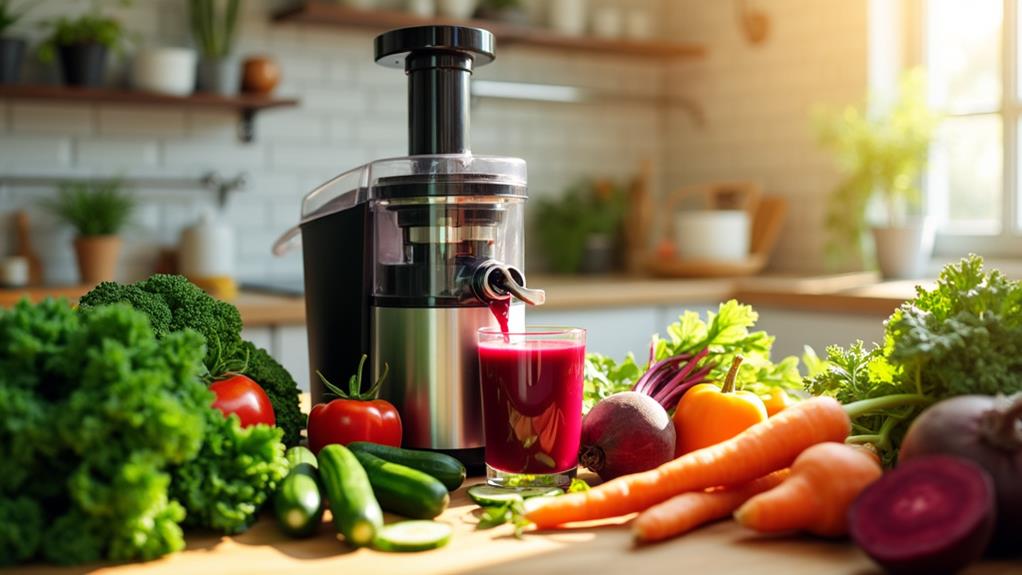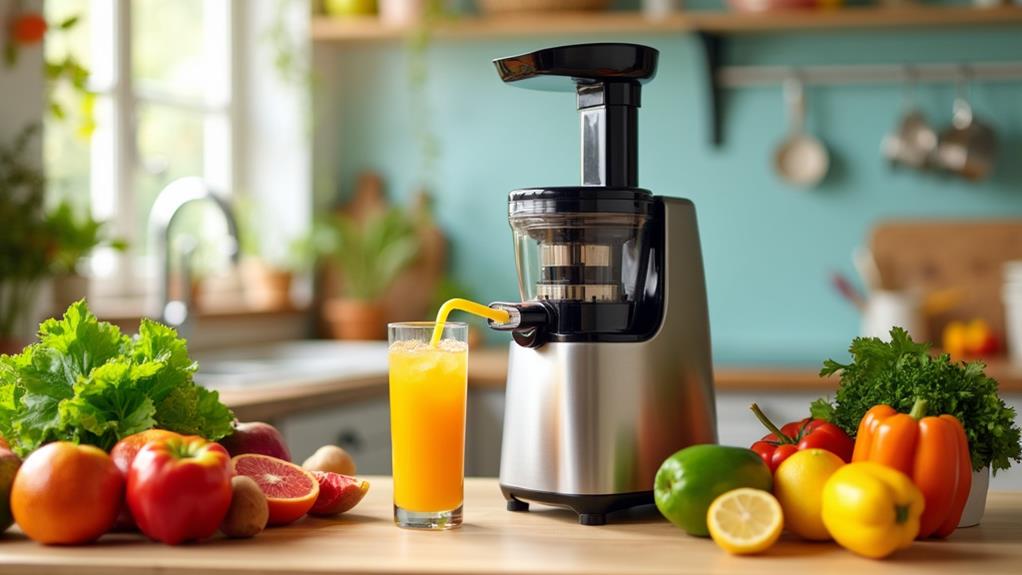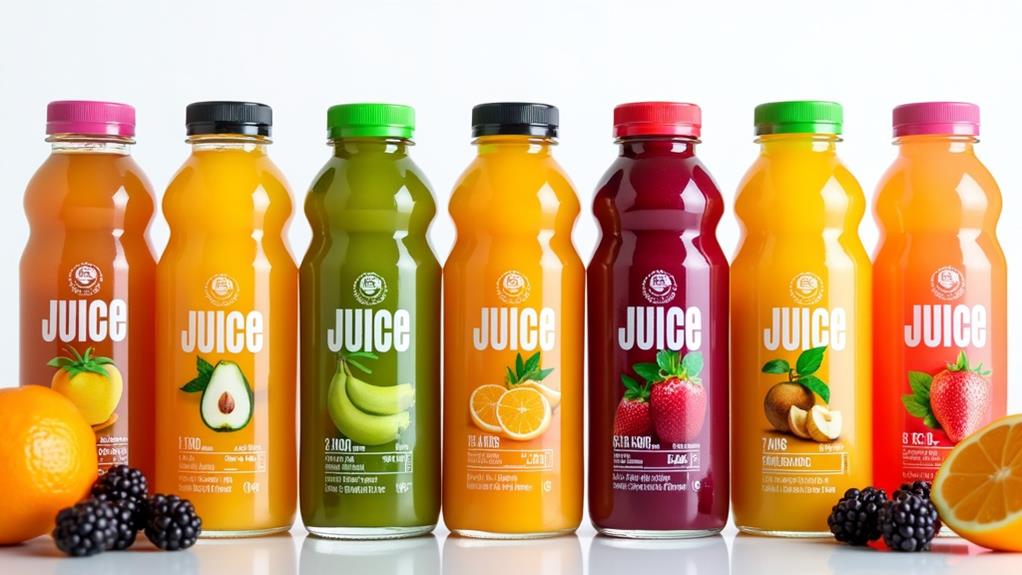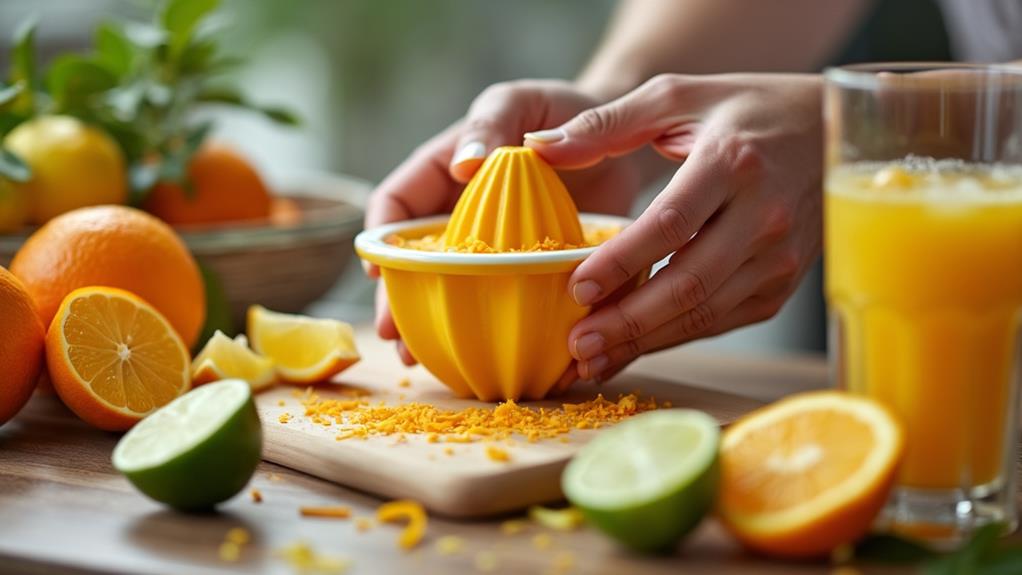Essential Guide to Washing Fruits and Vegetables
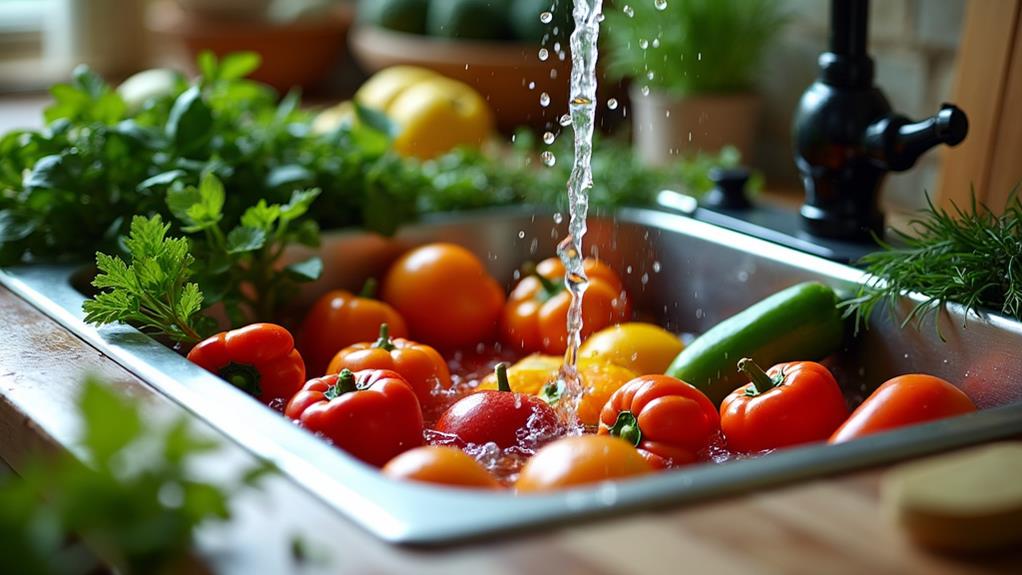
To wash fruits and vegetables effectively, start by rinsing them under cool running water for at least 10 seconds. It's crucial to skip soaps or detergents as they can leave harmful residues. Use a clean vegetable brush for firm produce like apples and cucumbers, and rinse delicate items like berries gently. Always begin with clean hands, and dry the produce with a paper towel or cloth to minimize bacterial growth. By washing your produce, you reduce risks of foodborne illnesses while enhancing the safety and nutritional benefits of your diet. There's more to uncover about peeling, storage, and safe handling.
Importance of Washing Produce
Washing fruits and vegetables is vital for keeping you and your family safe from harmful residues, dirt, and pathogens. By washing your produce, you greatly reduce the risks of foodborne illnesses like Salmonella and E. coli. These pathogens can cling to the surfaces of fruits and vegetables, and if not cleaned properly, they can lead to serious health issues. Contamination can happen at different points in the supply chain, from farm to table, making it essential to wash your produce thoroughly.
You might wonder why washing is so significant. Well, the FDA and CDC both emphasize rinsing your fruits and vegetables under cool running water to improve food safety. It's not just about removing visible dirt or residues—it's about safeguarding against invisible threats that can have severe health outcomes, especially for vulnerable populations such as young children and older adults who are at higher risk for food poisoning.
Implementing proper washing techniques not only boosts the hygiene of your meals but also contributes to better general health. Clean produce means you're more likely to enjoy the full nutritional benefits, reducing the risks associated with consuming contaminated food. So, always make washing your produce a priority.
Safe Cleaning Methods
In relation to cleaning your fruits and vegetables, adopting safe methods is vital. Start by rinsing fresh produce under cool running water for at least 10 seconds. This simple step helps remove dirt and bacteria, making your produce safe to eat. Remember, you should never use soaps, detergents, or commercial produce washes, as these can leave harmful residues that you definitely don't want on your food.
For firm produce like apples and cucumbers, grab a clean vegetable brush to scrub away any surface contaminants. This method guarantees that you effectively clean produce without damaging it. On the other hand, delicate items like berries and mushrooms require a gentler touch. Rinse them carefully to avoid bruising while still removing any potential pathogens.
After washing, drying your produce with a clean paper towel or cloth is critical. This step reduces moisture, helping to minimize the risk of bacterial growth before you store them. Also, don't forget to wash your hands before and after handling fresh produce. By consistently following these safe cleaning methods, you can enjoy fresh fruits and vegetables that are not only delicious but also safe for you and your family.
Steps for Washing Produce
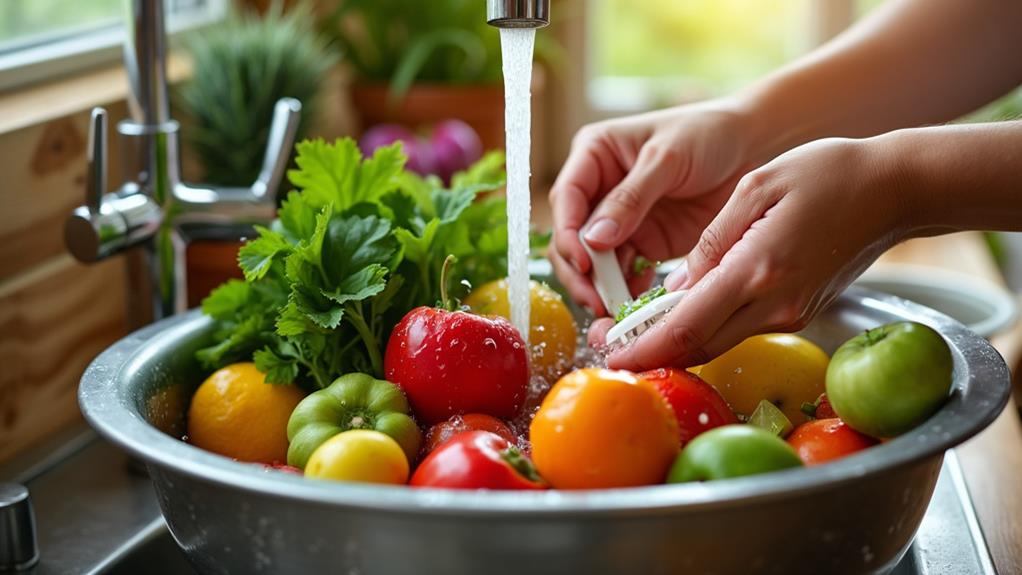
To start washing produce effectively, make sure your hands are clean by scrubbing them with warm, soapy water for at least 20 seconds. Clean hands prevent transferring dirt and bacteria to your fruits and vegetables. Next, rinse produce under cool running water for at least 10 seconds. Avoid using soap or detergents as they can leave harmful residues.
For firm fruits and vegetables like apples or potatoes, a clean vegetable brush is your best ally. Use it to scrub the surface while rinsing to guarantee dirt and bacteria are effectively removed. Leafy greens, such as lettuce or spinach, require a different approach. Soak them in a bowl of cool water, swish them around, and then rinse thoroughly to get rid of any lingering dirt or contaminants.
Once your produce is thoroughly washed, choose between air drying or using a clean paper towel. This helps prevent recontamination before storing or consuming. Air drying might take a bit longer, but it's effective. Using a clean paper towel can speed up the drying process, making sure your fruits and vegetables are ready for your next delicious meal. Following these steps makes certain your produce is safe and clean.
Nutritional Benefits
Now that your produce is clean and ready, let's investigate why eating fruits and vegetables is so beneficial to your health. Consuming a variety of fruits and vegetables provides fundamental vitamins and minerals critical for your well-being. They offer significant nutritional benefits, playing a key role in a healthy diet. Regularly eating these foods can help reduce the risk of chronic diseases like heart disease, diabetes, and certain cancers.
Here's why including fruits and vegetables in your meals is significant:
- Nutrient Density: They are low in calories but packed with nutrients, making them perfect for weight management and promoting healthy digestion.
- Variety of Nutrients: Incorporating a colorful variety guarantees you get a wide range of nutrients, supporting peak health outcomes.
- Daily Intake: The recommended intake for adults is 2-3 cups of vegetables and 1.5-2 cups of fruits daily, which varies based on life stage, sex, and activity level.
- Safety and Cleanliness: Washing produce helps reduce bacteria and pesticide residues, minimizing the risk of foodborne illnesses.
Peeling and Skin Considerations
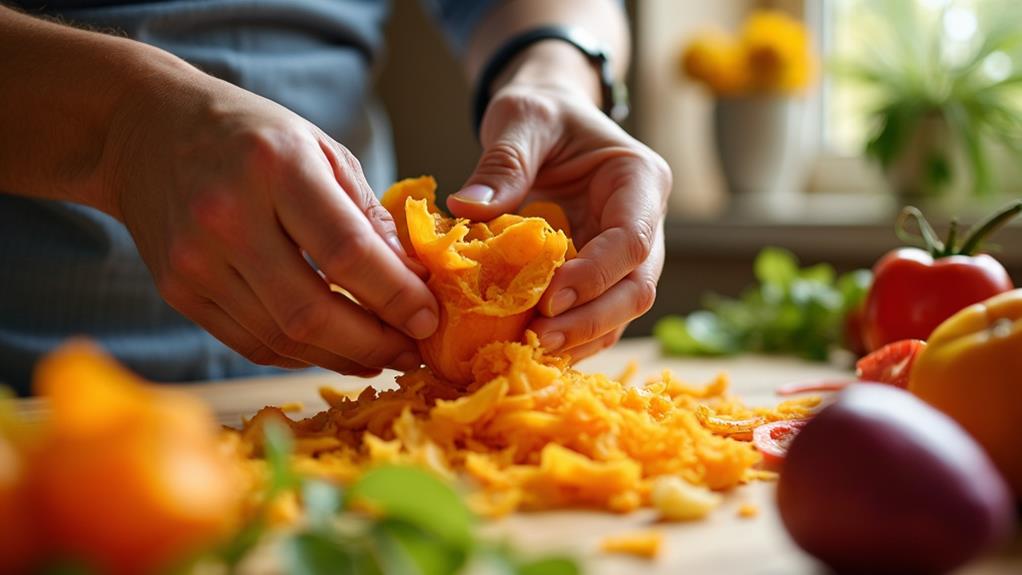
When considering if to peel fruits and vegetables, it's important to weigh the benefits and drawbacks. The skin of many fruits and vegetables holds beneficial nutrients and fiber, which are vital for a healthy diet. Consuming the skin can enhance your intake of these nutrients, provided it's safe. Washing produce thoroughly is key to reducing pesticide residues, allowing you to enjoy these nutritional benefits without risking exposure to harmful chemicals. Proper washing techniques can make eating the skin a safe option, improving your food's nutritional value.
However, there might be times when peeling is the better choice. Peeling can effectively eliminate potential contaminants, but it also removes those beneficial nutrients concentrated in or just below the skin. For certain vegetables, like potatoes, peeling is necessary to get rid of natural toxins. On the other hand, cucumbers can be consumed with the skin intact, offering added health benefits.
Your personal preferences and dietary choices play a significant role in deciding if to peel or not. Being mindful of pesticide exposure is important, so focus on using proper washing techniques to enhance health benefits during consumption.
Fresh vs. Frozen Produce
Choosing between fresh and frozen produce often depends on your priorities for flavor, convenience, and nutrient retention. Fresh produce usually boasts superior flavor and texture because it's picked at peak ripeness. However, it has a shorter shelf life, requiring you to consume it soon after purchasing from the grocery store. On the other hand, frozen produce can be stored for months, retaining its nutrient content since it's frozen shortly after harvest.
Here's a handy breakdown to guide your choice:
- Shelf Life: Fresh produce needs prompt consumption, while frozen produce offers extended usability, reducing waste.
- Nutrient Content: Both fresh and frozen options retain significant vitamins and minerals, but freezing locks in nutrients quickly.
- Flavor and Texture: Fresh produce excels here, though slight texture changes may occur in frozen varieties.
- Cost and Access: Seasonal fresh produce can be cheaper and supports local farmers, whereas frozen options provide year-round convenience.
When you opt for fresh, don't forget the importance of washing fresh fruits and cleaning produce thoroughly before consumption. Each choice has its benefits, so consider what best suits your needs and lifestyle.
Safe Handling and Storage
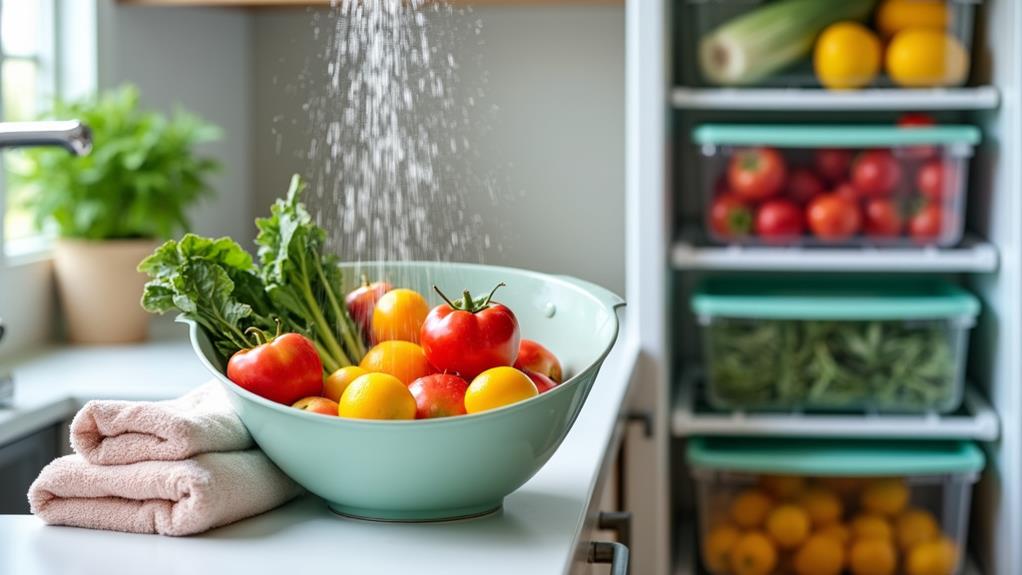
In the domain of safe handling and storage, ensuring the longevity and quality of your fresh produce requires a few fundamental practices. Start by washing produce thoroughly, rinsing under cool running water to remove dirt and potential contaminants. Always begin with clean hands and utensils to minimize the risk of bacterial transfer, promoting safe handling habits.
Once you've prepped your fresh produce, proper storage is essential. For perishable items, refrigeration is key. Keep your refrigerator set between 35-40°F to maintain ideal storage temperatures, thereby extending shelf life and preserving freshness. It's not just about temperature; how you store your produce matters too. Use airtight containers to minimize exposure to air, reducing spoilage and preserving quality.
Another significant tip is to store fruits and vegetables separately. Some fruits release ethylene gas, which can accelerate spoilage in nearby vegetables. By keeping them apart, you help maintain their freshness for longer periods. Aim to consume your produce within a few days of purchase, ensuring you enjoy them at peak quality and safety. By following these guidelines, you'll enhance the benefits of your fresh produce and keep your meals delicious and safe.
Waste Reduction Strategies
After mastering safe handling and storage of your produce, it's time to contemplate how you can minimize waste. You can make a significant impact by planning meals and creating shopping lists. This approach helps avoid impulse purchases, ensuring all fresh fruits and vegetables are used efficiently. Think about these strategies:
- Freezing Surplus: If you have fresh fruits and vegetables nearing expiration, freezing them is an excellent way to maintain their nutritional value and minimize waste. Make sure they're washed prior to freezing to maintain quality.
- Composting: Don't throw away peels and scraps. Composting organic waste reduces landfill contributions and enriches your garden soil, promoting sustainable gardening practices.
- Utilize Scraps: Vegetable peels on your cutting boards can be repurposed into stocks or broths, maximizing resource use and adding flavor to your meals. It's a creative way to cut down on waste.
- Buy Seasonal Produce: Opting for seasonal produce is both cost-effective and waste-reducing. These items are fresher and last longer than out-of-season varieties, reducing the chance of spoilage.
Food Safety Guidelines
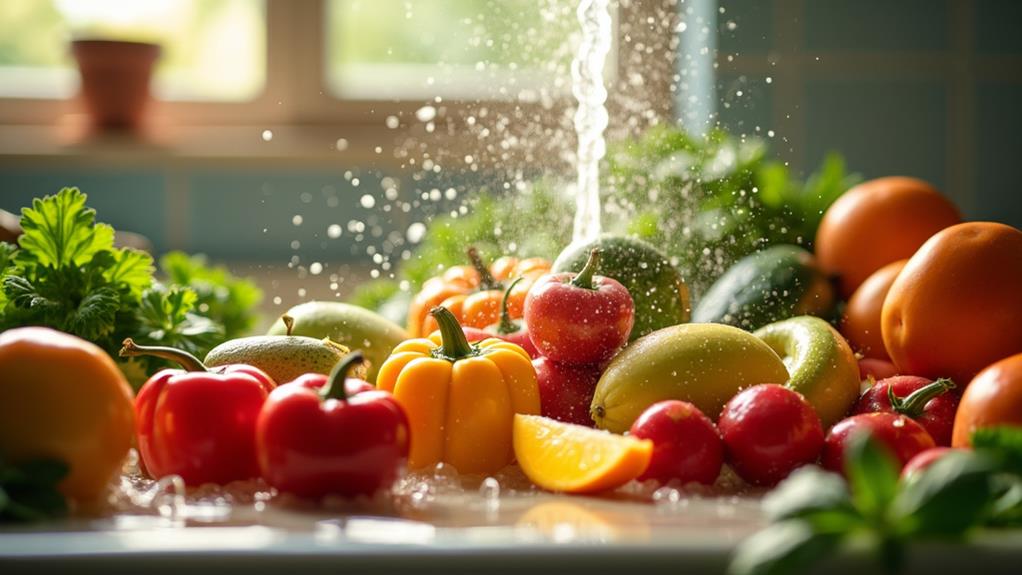
Guaranteeing food safety in your kitchen starts with a clean workspace. Begin by cleaning and sanitizing your kitchen counters to prevent cross-contamination from harmful bacteria. Use separate cutting boards for fresh fruits and vegetables and raw meats. This distinction minimizes the risk of foodborne illnesses. When handling produce, rinse under cool running tap water. It's crucial for both firm produce and delicate items.
For leafy greens, a produce wash can be handy, but simply rinsing thoroughly under tap water is often effective. Washing delicate fruits requires a gentle touch to prevent damage while still guaranteeing cleanliness. Cook your produce to a minimum internal temperature of 135°F to kill any pathogens, maintaining the Health Benefits while guaranteeing safety.
After washing, keep cut produce at or below 41°F until you're ready to eat it. This helps maintain its freshness and prevents spoilage. Always consume cut or cooked produce within seven days. By following these guidelines, you guarantee the food you serve is not only fresh but also safe for consumption. Remember, your kitchen hygiene practices directly impact your health and well-being.

